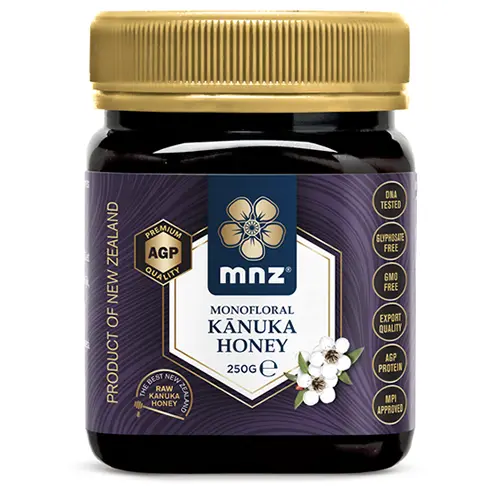Kanuka honey (from Kunzea ericoides) is a rare honey from New Zealand, produced only when the Kanuka tree is in bloom. This honey is made just a few weeks each year and is known for its delicate flavour, light colour, and floral aromas. Unlike Manuka honey, Kanuka honey is less robust but refined and subtle. A key feature of Kanuka honey is the presence of AGP proteins (arabinogalactan proteins), natural compounds that occur specifically in this honey type. The unique qualities of Kanuka honey are shaped by New Zealand’s pristine nature — from its clean environment to the diverse conditions where the Kanuka tree thrives.
The Kanuka tree is often regarded as the “sister plant” of Manuka. Both belong to the myrtle family, but Kanuka grows taller, can live for decades, and covers vast hillsides and valleys. In Māori tradition, Kanuka was used for wood, infusions, and ritual purposes. With the arrival of honeybees in the 19th century, Kanuka nectar was for the first time turned into honey — a specialty that has since gained increasing recognition.
The Kanuka blossom is smaller and more delicate than that of Manuka, yet produces abundant nectar during its short blooming season.

Who is Kanuka honey for?
Kanuka honey is a versatile New Zealand honey suitable as a daily addition to the diet for anyone over the age of one. Thanks to its gentle taste, it is ideal to enjoy straight from the spoon, stir into warm drinks, or use as a natural sweetener for breakfast and desserts. It is especially valued by those who prefer a milder honey over the strong character of Manuka.
Because the Kanuka bloom is relatively short, the honey is scarce. Beekeepers must carefully place their hives and harvest on time. This makes Kanuka honey an exclusive seasonal product, directly tied to New Zealand’s natural cycles.
Why raw Kanuka honey?Raw Kanuka honey is exactly as nature intended: pure, raw, unprocessed, unpasteurised, and unheated. This preserves the natural enzymes, aromas, and its characteristic light flavour. The unique AGP protein also remains intact, setting Kanuka honey apart from other types. Raw Kanuka honey crystallises naturally and has a soft, fine texture that spreads easily.
Its pale colour and floral tones reflect the Kanuka blossom itself. Where Manuka is often darker with a robust taste, Kanuka is known for clarity and refinement — making it appealing to anyone seeking a subtle alternative within New Zealand’s honey range.
What makes Kanuka honey special?
Kanuka honey is unique for its light, floral flavour, bright colour, and the presence of AGP proteins. It is a monofloral honey: the nectar comes predominantly from the Kanuka tree of New Zealand. This makes it an authentic honey that reflects the biodiversity and nature of its homeland.
Often described as New Zealand’s “hidden gem,” Kanuka is gaining recognition alongside Manuka. Its seasonal nature and limited availability add to its exclusivity.
How to use Kanuka honey
Kanuka honey can be enjoyed in many ways: straight from the spoon, stirred into warm drinks, or as a natural sweetener for breakfast, lunch, or desserts. Its mild flavour pairs especially well with yoghurt, fruit, and baked goods.
In New Zealand, Kanuka honey is often sold locally in small batches. Beekeepers highlight that each harvest carries its own nuance, influenced by region, rainfall, and sunshine during the bloom. This makes every jar a true reflection of nature in that season.
What is known about Kanuka honey?
Kanuka honey is a genuine New Zealand honey that is gaining global recognition. Where Manuka is renowned for its strong, robust profile, Kanuka is appreciated for its softer floral notes and its unique AGP proteins. This makes it a distinguished alternative among New Zealand’s honeys.
Historically, Kanuka was valued by indigenous communities for its wood and leaves. Today, it is the honey that earns international appreciation, showing how both tradition and modern beekeeping contribute to Kanuka’s value.

